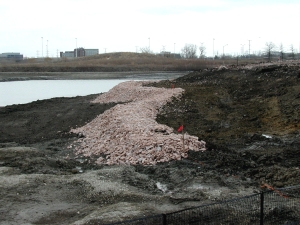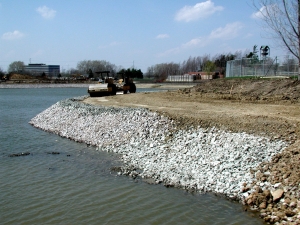Treatment 2: Underwater Stone Berm
This treatment was used in shoreline areas where construction needed to occur at least partially "in the wet" (i.e., without the lake water completely drained). Upon completion of construction, this treatment functions essentially the same as the clay soil shelf (Treatment 1). Because the shelf needed to be constructed without completely drawing down the lake, clay could not be compacted in place. Instead, the entire shelf (except for the planting bed soil layer) was constructed of angular granite stone. The stone shelf was then topped with a clay soil planting medium (accomplished in the dry after the lake was drawn down at least two feet). The slope of the shelf varied from 10H to 20H:1V over a depth range of 0 to 2 feet. The shelf was planted with emergent and floating-leaved vegetation.

Treatment 2: Cross-sectional view
Treatment 2: Construction sequence of underwater stone berm with lake water mostly removed



Treatment 2: Construction sequence of underwater stone berm with lake water only partially removed
As with the clay soil shelf, this method provides long term shoreline stabilization and creates important wetland and aquatic habitat. The primary disadvantage to this approach is that it is more expensive to construct than the clay soil shelf, primarily due to the cost of importing and placing stone (versus less-expensive clay fill).

Treatment 2: Before shoreline restoration
Treatment 2: After shoreline restoration

Treatment 2: Before shoreline restoration
Treatment 2: After shoreline restoration





